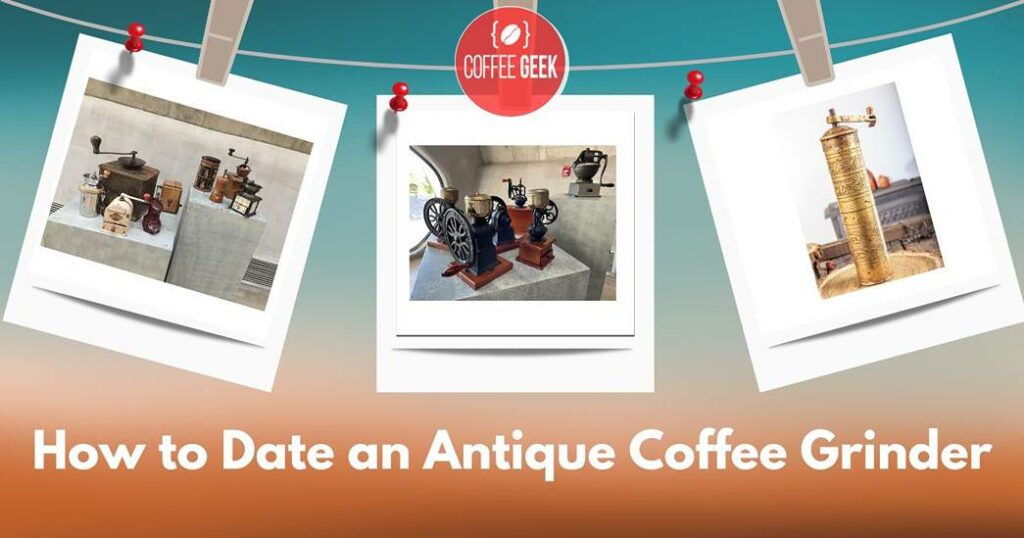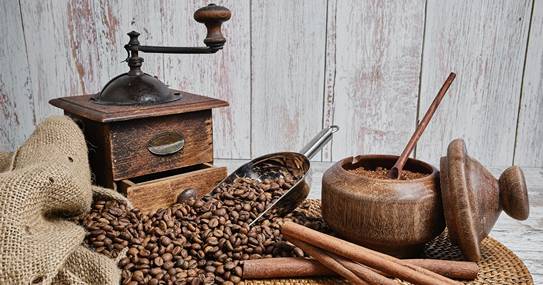Antique coffee grinders are fascinating collectibles that reveal insights into the history of coffee preparation.
These grinders range in design, materials, and complexity, adding a unique touch to your collection.
Before you can enjoy your antique coffee grinder’s historical value and beauty, it’s essential to know how to accurately date it and understand its origin.
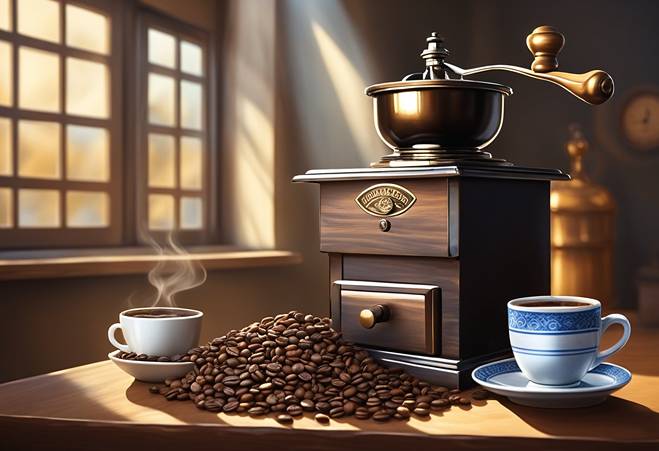
Dating antique coffee grinders involves examining various aspects, including patents, model numbers, and country codes that may be present on the device. How to date an antique coffee grinder?
Additionally, you can learn about the materials and construction of the grinder, such as wood or metal walls, glass, ceramic, or steel components.
By understanding the age, origin, and condition, you can better assess the value of your antique coffee grinder, ensuring that you properly maintain and appreciate it.
Key Takeaways
- Accurately dating an antique coffee grinder involves examining patents, model numbers, and country codes on the device
- Assessing the materials and construction of the grinder can reveal its age and origin
- Understanding the age, origin, and condition helps determine the value of an antique coffee grinder
Understanding Antique Coffee Grinders
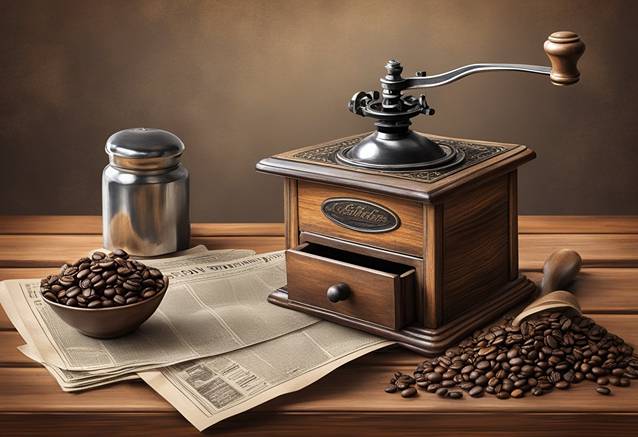
History of Coffee
Antique coffee grinders are fascinating pieces of history that offer a glimpse into the evolution and craftsmanship of coffee preparation.
The history of coffee grinders dates back to the origin of coffee itself, when people sought methods to grind coffee beans for brewing.
Coffee was first discovered in Ethiopia around the 9th century and quickly spread to different parts of the world.
As coffee’s popularity grew, so did the need for efficient ways to grind the beans. Early coffee grinders were simple manual devices made of wood or metal.
They consisted of two parts: a top container where beans were inserted and a bottom container for the ground coffee.
The beans were ground by rotating a handle attached to a mechanism inside.
With time, the design of coffee grinders evolved to cater to various needs and aesthetic preferences.
During the late 18th and early 19th centuries, cast iron box mills became popular, featuring intricate decorations and appealing to collectors of antiques.
Wall-mounted grinders were another popular option, allowing for easy and convenient grinding in busy households.
When aiming to date your antique coffee grinder, consider several factors:
- Materials: Early grinders were made of wood or metal, while later models incorporated glass or ceramic components.
- Construction: Examine the thickness of the walls or the presence of any decoration or design elements that could indicate age, such as Victorian opulence.
- Maker’s Marks: Look for any identifying marks or model numbers that could reveal the grinder’s age or manufacturer.
For example, an antique coffee grinder can be dated by patents, model numbers, and country codes found on their base or top.
Additionally, you can take into account its historical context, the time period, and country of origin to narrow down its age.
Dating an antique coffee grinder accurately not only requires an understanding of the history of coffee but also awareness of the technological advancements and the evolving designs of different periods.
By considering the material, construction, and identifying marks, you can better appreciate the story behind your antique grinder and its place in the long and colorful history of coffee grinding.
How To Date An Antique Coffee Grinder?
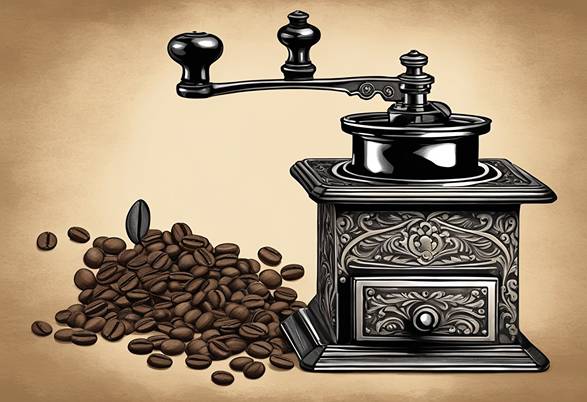
When trying to date an antique coffee grinder, it’s crucial to examine the various features and characteristics of the item.
In this section, we will discuss two major aspects to consider: distinguishing features and common models and makes.
Distinguishing Features
An antique coffee grinder’s age can be determined by examining its materials, construction, and identifying marks.
Early grinders from the 1700s used brass and wood, while later ones incorporated glass, ceramic, and steel.
Throughout different periods, unique design elements were introduced, such as cast iron bodies or intricate patterns.
Keep an eye out for markings or serial numbers, which can help you pinpoint the manufacturing period.
Patent dates also offer significant clues about a grinder’s age.
Research the patent number and date to understand when the grinder’s innovation was officially recognized.
Here are some key features to look for:
- Material: Brass, wood, glass, ceramic, steel, or cast iron
- Construction: Bolted or screwed elements, base design, handle and wheel style
- Markings: Brand logos, serial numbers, patent dates, and other identifying marks
Common Models and Makes
Familiarizing yourself with renowned antique coffee grinder manufacturers can greatly assist in dating your grinder.
Some prominent makers include Enterprise, Parker, Wrightsville Hardware Company, Logan and Stonebridge, and Landers Frary and Clark.
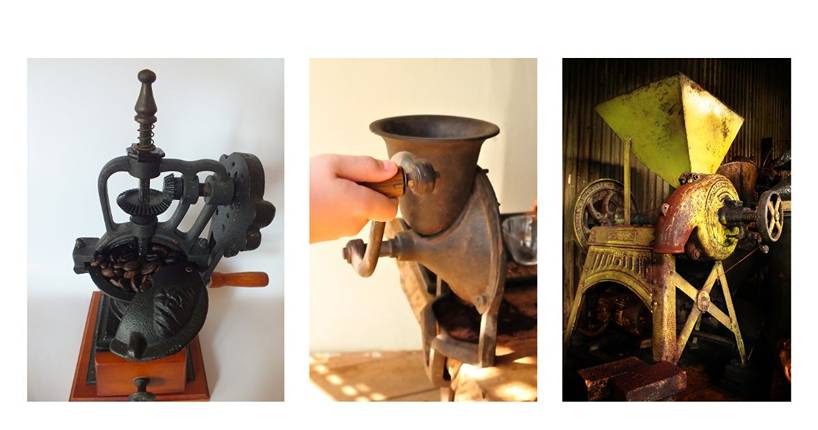
Many of these manufacturers stamped their brand or logo on labels or parts of the grinder.
If this identifier is visible, you can determine the brand of the coffee grinder and use it as a clue in the dating process.
Here are a few notable manufacturers:
- Enterprise: Known for their large ornate cast iron designs, often with detailed, embossed patterns.
- Parker: Produced high-quality cast iron grinders, sometimes marked with the name “Charles Parker.”
- Wrightsville Hardware Company: Produced coffee grinders under the brand “Queen”; recognizable by their tin construction and small size.
- Logan and Stonebridge: Recognizable by their distinct rectangular shape and sturdy tilting handle.
- Landers Frary and Clark: The “Universal” line of grinders with cast iron or tin bodies and a variety of designs.
In summary, pay close attention to distinguishing features such as materials, construction, and identifying marks while also being aware of common models and makes.
By focusing on these aspects, you can more accurately date your antique coffee grinder.
Materials and Construction

Types of Materials
The materials used in antique coffee grinders can tell you a lot about their age and origin. Commonly used materials include wood, cast iron, brass, and porcelain.
In the early days of coffee grinder production, wood was the primary material used for both the body and the mechanism.
Later on, coffee grinders were made with cast iron, brass, and porcelain, each adding to the overall aesthetics of the grinder.
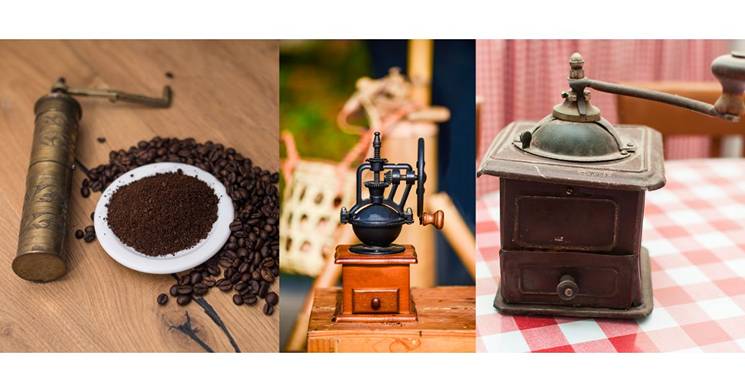
You may sometimes find dovetail joints as a telltale sign of antique construction, especially in wooden grinders.
As for metal grinders, they may show signs of rust or patina, which can indicate their age.
- Early 1700s grinders: Typically made of wood or metal
- 1800s grinders: Often cast iron or brass
- 1900s grinders: Occasionally made of porcelain or other materials
Grinder Mechanism
The grinder mechanism is another critical aspect to consider when dating an antique coffee grinder.
Early grinder mechanisms often featured metal gears made of materials such as brass or cast iron. As time went on, the mechanisms were refined and improved.
Take note of the grinder’s mechanism and look for specific markers of age and origin.
Here are some pointers to keep in mind when evaluating the grinder mechanism:
- Early mechanisms often feature metal gears and simple constructions.
- Cast iron and brass gears usually indicate a grinder from the 1800s or early 1900s.
- If you come across ceramic or steel mechanisms, it might be a more modern coffee grinder.
While examining the materials and construction, keep an eye out for any identifying markers or specific design details.
This attention to detail can go a long way in determining the authenticity and age of your antique coffee grinder.
Determining the Age and Origin
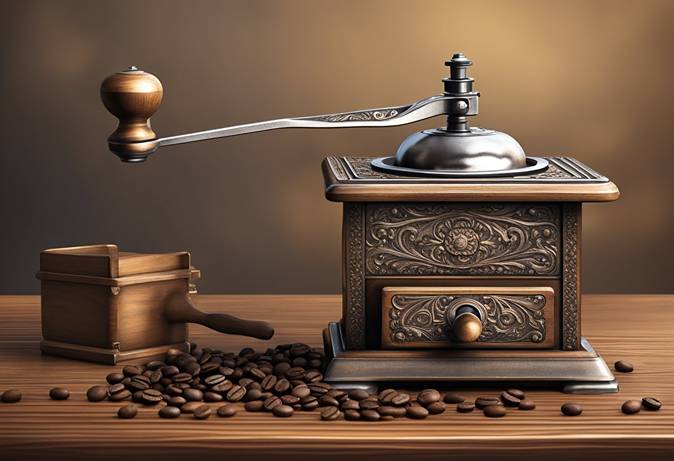
When trying to date an antique coffee grinder, understanding its age and origin is essential.
In this section, we will discuss various methods that can help you determine the age and origin of your antique coffee grinder, including serial and patent numbers, labels and markings, and historical context.
Serial and Patent Numbers
Serial numbers and patent numbers can often be found on the base or top of antique coffee grinders.
Examine your coffee grinder for any serial or patent numbers, as they can provide valuable information about its manufacturing date.
Grinders with lower serial numbers are generally older than those with higher serial numbers.
European grinders, for example, often have their patents listed as “D.R.G.M” (Deutsches Reich Gebrauchsmuster), while American grinders may have either “U.S. Patent” or “Pat. Applied For” written.
Identifying these markings can help you narrow down the country of origin.
Labels and Markings
Labels and markings on antique coffee grinders offer additional clues about their age and origin.
These may include manufacturer’s marks, country codes, or specific model information.
Pay close attention to any logos, symbols, or text found on your grinder.
It is also helpful to check for any differences in construction materials and design details.
For example, grinders from the early 1700s may have wood or metal walls, whereas later grinders may have glass, ceramic, or steel construction.
Historical Context
Understanding the historical context of antique coffee grinders can also help you determine their age and origin.
For instance, coffee grinders originated in Turkey and Ethiopia, making them essential parts of their respective coffee cultures.
However, as coffee spread throughout Europe and America, coffee grinders began to be produced in these regions, often with different designs and materials.
By researching historical catalogs and comparing styles, you may be able to identify which era or region your grinder belongs to.
In conclusion, dating an antique coffee grinder requires careful observation of serial and patent numbers, labels and markings, and historical context.
By combining each of these elements, you’ll be better equipped to determine the age and origin of your antique coffee grinder, giving you a deeper appreciation for its unique history and craftsmanship.
Assessing Condition and Value
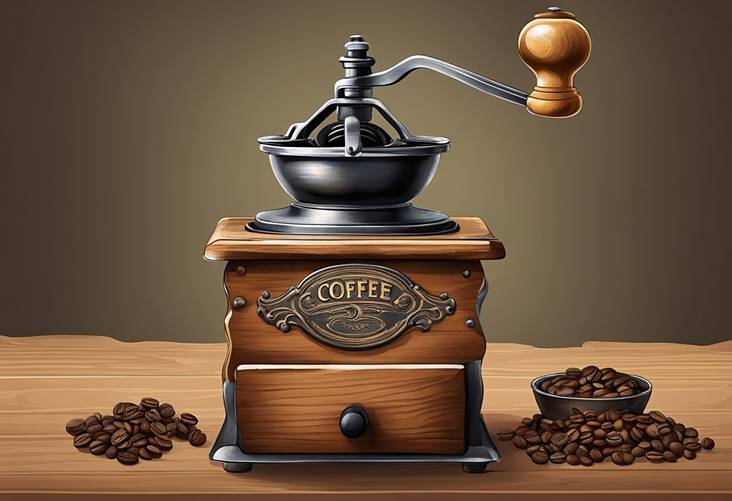
Evaluating Condition
To assess the condition of your antique coffee grinder, you should first examine its overall appearance.
Look for any signs of wear, damage, or repairs.
The presence of original parts, such as the handle, grinding mechanism, and hopper, significantly impact the item’s desirability.
Take note of the materials used and any ornate designs that may indicate the grinder’s age and origin.
Functionality is another key factor to consider. Ensure the grinder is operable and still capable of producing a consistent grind.
Test the grinding mechanism by turning the handle and inspecting the gears for any signs of corrosion or excessive wear.
It is important to document your observations with photographs or notes, as these will help you determine your antique coffee grinder’s value.
Market Value Factors
Market value depends on several elements, including condition, rarity, and demand.
The age of the grinder and its design are significant aspects determining its price.
Some of the market value factors to consider are:
- Design: Look for unique or intricate designs on your antique coffee grinder, as these tend to be more valuable.
- Age: Older and rarer grinders typically fetch higher prices.
- Provenance: The grinder’s history and origin might affect its value, especially if it is connected to a notable person or event.
- Condition: As mentioned earlier, the condition plays a major role in determining value. Good working condition, with minimal damage, is preferred.
- Popularity: Research the demand for your specific grinder model. High demand leads to higher market value.
It is essential to research comparative sales to help guide your valuation.
Comparing similar antique coffee grinders that have recently sold, or are currently for sale in various online platforms and antique shops, will give you an idea of the price range.
When discussing market-value factors, remember that these elements are not equal.
Some might affect the value more than others, and it is ultimately up to the buyer to determine their preferences.
Appraising and Authenticating

Professional Appraisal
One of the best ways to determine the value and authenticity of an antique coffee grinder is to consult a professional appraiser.
You can find an appraiser through a local antique shop or by searching online for appraisers in your area.
A professional appraisal will give you a reliable estimate of your coffee grinder’s worth, taking into account factors such as age, condition, and rarity.
Research and Reference
Another way to estimate the value of your antique manual coffee grinder is to conduct your own research.
Start by searching on Google for similar items, which will give you an idea of the item’s market value.
You can also check reference books and online resources specializing in antiques to learn more about your coffee grinder’s background.
When looking online, browse through auction sites and eBay listings to see how similar items are priced and sold.
Keep in mind that prices may vary greatly, so it’s essential to compare several sources and explore different condition ratings.
Common resources for researching antique coffee grinders:
- Online antique forums
- Reference books dedicated to coffee grinders and antiques
- Auction sites like eBay and Paddle8
Antique Verification
Verifying the authenticity of your antique coffee grinder is essential to ensure its true value and historical significance.
You can do this by examining the grinder’s various physical attributes, like the materials used, maker’s marks, and any accompanying documentation.
Also, look for patent dates or numbers that may be present, as these can reveal the grinder’s age and origin.
In some cases, you might need expert assistance in antique verification, particularly if you are dealing with a rare or highly valuable piece.
In these cases, consider consulting an antique dealer or appraiser to confirm the coffee grinder’s authenticity and age.
Tips for verifying an antique coffee grinder:
- Examine the materials and craftsmanship for signs of age and origin
- Look for maker’s marks and patent numbers, if present
- Consult a professional for a more in-depth analysis, if needed
| Step Number | Step Description |
|---|---|
| 1 | Research the brand and manufacturer of the coffee grinder. This information can often be found stamped or engraved on the grinder itself. |
| 2 | Examine the design and materials used in the construction of the grinder. Older models may have different features and materials compared to newer ones, which can help in dating the grinder. |
| 3 | Look for any patent numbers or markings on the grinder. These can provide clues about when the grinder was patented and potentially manufactured. |
| 4 | Check for any historical advertisements or catalogs from the manufacturer. These can help in determining the time period when the grinder was produced. |
| 5 | Consult with experts or collectors specializing in antique coffee grinders. They may have knowledge about specific models and their production dates. |
| 6 | Compare the grinder with similar models found in museum collections or online databases of antique coffee grinders. This can give you a better understanding of its age and rarity. |
| 7 | Consider the condition of the grinder. Signs of wear and tear, as well as any modifications or repairs, can offer insights into its age and usage history. |
| 8 | Utilize online forums or communities dedicated to antique coffee grinder enthusiasts. Fellow collectors may share valuable information or experiences related to dating similar items. |
Conclusion
Dating an antique, vintage coffee grinder can be an intriguing journey through history, offering insights into the craftsmanship and design preferences of bygone eras.
The first step in this process involves identifying the coffee mill’s type, whether it’s an old coffee grinder, a vintage coffee mill, or a more specific antique coffee mill.
Some of the renowned manufacturers are Peter Dienes, Elma, or a German company known for quality coffee mills.
Many coffee grinders were crafted with unique features, from the type of burr used to grind the coffee, to the material of the coffee mill itself, which could range from cast iron components to old wooden bases with a mortar and pestle mechanism.
The exact year of manufacture might be difficult to pinpoint without closer inspection, but comparing your coffee mill to similar models in the MacMillan Index or consulting with antique collectors who specialize in coffee grinders can provide valuable clues.
Key identifiers include the grinder’s size and weight, the materials used (like sheet metal, white glass, or wood), and any brand and model information that might be visible.
European coffee mills, particularly those made around 1900 or featuring art deco designs, often carry distinctive stylistic elements that can help in the dating process.
Additionally, the condition of the grinder, such as missing parts or signs that it can still grind coffee, plays a crucial role in determining its age and value.
Remember, the goal isn’t just to find out if your old coffee grinder is worth a tidy sum; it’s also about appreciating the story and craftsmanship behind the piece.
Whether you’re in luck finding a Clark coffee mill in your grandmother’s attic or you’ve acquired a vintage grinder at a flea market, knowing what to look for can make all the difference.
Keep in mind that while it might be tempting to restore an old grinder, the patina and wear can often tell you something about its history and authenticity, adding to its charm and potentially its value among collectors and enthusiasts.
Frequently Asked Questions
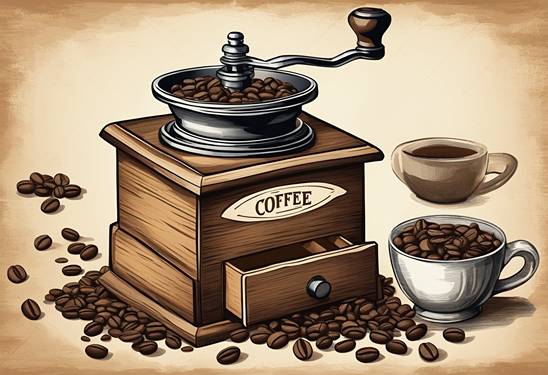
How do I start dating antique coffee grinders?
To date an antique coffee grinder, begin by examining physical features such as material, design, and construction.
Mills were made of wood, metal, or ceramic, with design trends varying by era.
Knowing the brand and identifying any marks or stamps can also give clues, as can consulting recent posts or guides on antique coffee grinders.
What are the key things to consider when trying to date an old coffee grinder?
When dating an old coffee grinder, consider the type of coffee grinder, materials used (mills were made of wood or metal), and any distinctive design features.
Knowing the brand and researching the history of European manufacturers can offer insight.
Don’t overlook details like the grind size setting or how the drawer for coffee grounds operates, as these can indicate age.
How can I tell if my grinder at home is an antique?
To determine if your grinder at home is an antique, look for signs of age and wear, such as a patina on metal parts or wear on moving parts.
Older grinders might also lack modern features like electric grinding mechanisms. Upon closer inspection, historic craftsmanship details or identifying marks from known antique brands can confirm its status.
Can I use an antique coffee grinder to make my daily coffee?
Yes, you can use an antique coffee grinder for your daily coffee, but there are things to consider.
Ensure the grinder works properly and that the grind size can be adjusted to your brewing method.
Be aware that very old grinders might deteriorate over time, potentially affecting the flavor of your coffee grounds.
Regular maintenance is crucial to keep an antique grinder functioning well.
What are the main differences between an old coffee grinder and a modern electric one?
The main differences between an old coffee grinder and a modern electric one include the grinding mechanism, materials, and power source.
Older grinders typically have a manual crank system, while electric grinders use a motor.
Antique grinders are often made from materials like wood and metal, giving them a distinct appearance compared to the plastic and metal of electric models.
Additionally, the grind size on antique models might be less consistent than what you’d achieve with a modern grinder.
How difficult is it to date an antique coffee grinder?
Dating an antique coffee grinder can be challenging due to the lack of comprehensive records on older models and variations in design and materials used over time.
However, knowing the brand, recognizing material and construction styles, and referencing recent posts or guides dedicated to antique coffee grinders can give you a good idea of how much your grinder isn’t just old but antique.
Why would someone want to restore an antique coffee grinder?
People often want to restore an antique coffee grinder to preserve a piece of history, integrate a unique decorative item into their home, or because they appreciate the quality of grind and flavor profile from manually ground beans.
Restoration can also significantly increase the value of a grinder, with some restored pieces selling for hundreds of dollars.
Where can I find more information about dating and using an antique coffee grinder?
For more information on dating and using an antique coffee grinder, check recent posts and forums online dedicated to coffee and antiques.
Visiting antique shops, talking to experts in vintage kitchenware, and consulting books on antique coffee mills are also excellent ways to gather valuable insights.

